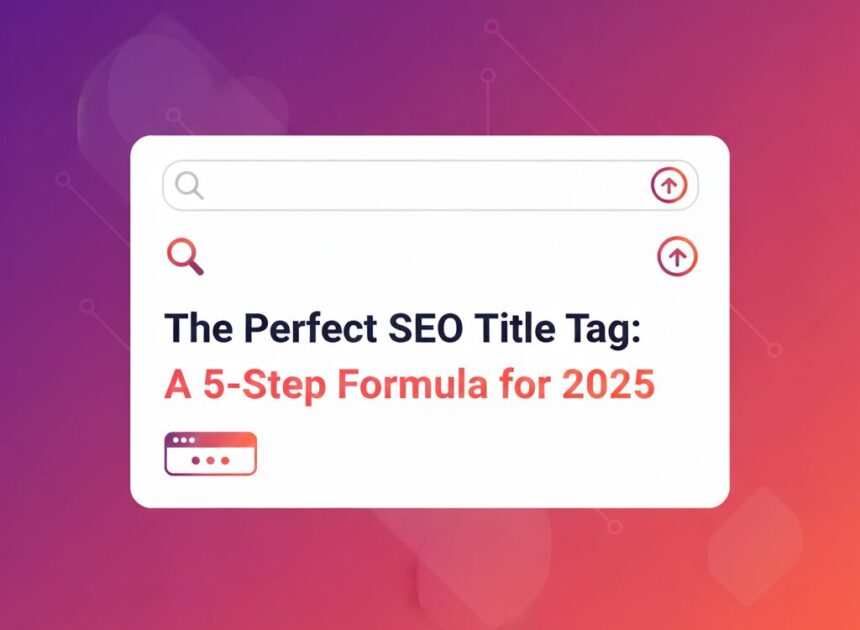What if your most powerful SEO weapon wasn’t a complex backlink strategy or a massive content piece, but a simple line of text under 60 characters? In today’s crowded search landscape, visibility is everything. Businesses spend fortunes trying to rank higher, yet many overlook the single most important element for standing out on the search engine results page (SERP).
This guide is here to change that. We’re going to unveil a simple, repeatable 5-step formula for crafting the perfect SEO title tag. This isn’t just a minor tweak; it’s a high-leverage change that can create an outsized impact on your rankings and, more importantly, your click-through rates in 2025.
Why Your SEO Title Tag is a High-Leverage Ranking Factor
Before diving into the “how,” it’s crucial to understand the “why.” Your title tag isn’t just a bit of text; it’s a critical piece of SEO infrastructure that serves three distinct, powerful roles.
The First Impression in the SERPs
Think of your title tag as the headline of your digital billboard. It’s the blue, clickable text that users see first in Google’s search results. In a sea of competing links, this title is your one chance to grab a searcher’s attention and convince them that your page has the answer they need. A clear, compelling title builds instant trust and directly influences a user’s decision to click on your result over a competitor’s.
A Direct Signal to Search Engines
Beyond its role for human users, the SEO title tag is a primary signal to search engines like Google. It provides a concise, high-level summary of the page’s content. When Google’s crawlers analyze your page, they place significant weight on the words in your title tag to understand its main topic. A well-optimized title helps Google accurately categorize and rank your page for relevant queries.
The Undeniable Link to CTR
This is where the magic happens. CTR, or Click-Through Rate, is the percentage of users who see your result and actually click on it. A compelling title can dramatically improve your CTR, which is a key factor in modern SEO.
Effective click through rate optimization means you can attract more traffic even without improving your rank. Imagine your page is ranked #4, but your title is so much more enticing than the bland titles at #1, #2, and #3. You could end up siphoning a significant number of clicks from the results above you. Google notices this user behavior and may reward your page with a higher ranking over time, seeing it as a more relevant result.
The 5-Step Formula for the Perfect Title Tag
Ready to turn your titles into click magnets? Follow this proven 5-step formula.
Step 1: Nail Your Keyword Research and Placement
Every great title starts with a solid keyword foundation. Your goal is to align your title with the exact language your audience is using.
- Start with a Primary Keyword: Each page should target one main keyword or phrase that accurately reflects its content and matches user search intent.
- Front-Load Your Keyword: Place your most important keyword as close to the beginning of the title tag as possible. Users scan from left to right, and both they and search engines give more weight to words that appear first.
- Avoid Keyword Stuffing: Don’t just list keywords. Your title must read naturally. A title like “SEO Title Tag | Title Tag SEO | How to Write Title Tags” is spammy and will be ignored by users and penalized by Google.
Example:
- Poor: Learn All About Crafting an SEO Title Tag
- Good: SEO Title Tag: A 5-Step Formula for Higher Rankings
Step 2: Master the Ideal Length and Format
A title that gets cut off is a title that fails. Google doesn’t have a strict character limit; it has a pixel-width limit, which is typically around 600 pixels.
Because different characters take up different amounts of space (e.g., ‘W’ is wider than ‘i’), a character count is just an estimate. However, a general rule of thumb is to keep your titles between 50 and 60 characters to minimize the risk of it being truncated. A truncated title can hide your value proposition or keyword, killing your CTR.
Use a free tool like Moz’s Title Tag Preview Tool to see exactly how your SEO title tag will appear in the search results before you publish it.
Step 3: Add Modifiers and Power Words to Boost Clicks
A title with just a keyword is functional, but a title with compelling modifiers is irresistible. This is the core of how to write title tags that demand attention.
- Use Compelling Modifiers: Add words that provide extra context and value.
- Content Type: “Guide,” “Checklist,” “Formula,” “Examples,” “Review”
- Freshness: “[2025 Update],” “A New Study,” “For This Year”
- Leverage Power Words & Numbers: Trigger an emotional response and create intrigue.
- Words: “Proven,” “Effortless,” “Ultimate,” “Simple,” “Step-by-Step”
- Numbers: Using digits (e.g., “5 Tips” instead of “Five Tips”) draws the eye and promises a structured, easy-to-digest format.
- Use Brackets or Parentheses: Studies show that adding brackets or parentheses to a title can increase clicks. They visually break up the line of text and make your title stand out.
Example:
- Before: How to Train a Puppy
- After: How to Train a Puppy [8 Simple Steps for Beginners]
Step 4: Make it Unique and Brand-Aligned
Your website should not have duplicate title tags. Each title must be unique to the page it represents.
- Avoid Duplicates: Using the same title across multiple pages confuses Google and dilutes your SEO efforts. Perform a site audit to find and fix any duplicate titles.
- Analyze Competitors: Search for your target keyword and see what the top-ranking title tag examples look like. Don’t copy them. Instead, find a unique angle. If they all say “10 Tips,” maybe your title could be “The Ultimate Guide” or focus on a specific benefit.
- Include Your Brand: It’s often a good practice to add your brand name to the end of your title tag, separated by a pipe | or a hyphen -. This builds brand recognition, especially if you have an established reputation. However, if your brand name is long and pushes the title over the length limit, consider leaving it out.
Step 5: Test, Measure, and Refine for a Higher CTR
Crafting the perfect SEO title tag isn’t a one-time task; it’s an ongoing process of improvement. Your best tool for this is Google Search Console.
- Identify Opportunities: In Google Search Console, go to the “Performance” report. Look for pages that have high impressions but a low CTR. These are your prime candidates for a title tag update.
- A/B Test Your Titles: Don’t just guess what works. Form a hypothesis, change the title of a low-CTR page using the formula above, and let it run for a few weeks.
- Measure the Impact: Compare the CTR of the page for the period before and after the change. Did it improve? If so, you’ve found a winner. If not, try another variation. This continuous loop of testing is the secret to sustained click through rate optimization.
Real-World SEO Title Tag Examples (Good and Bad)
Let’s see the 5-step formula in action.
Title Tag Examples That Win the Click
- Blog Post: How to Start a Blog in 2025 (The Simple 7-Step Guide) | HubSpot
- Why it works: The keyword is front-loaded, it uses the current year for freshness, includes a number and a compelling modifier (“Simple 7-Step Guide”), and ends with a strong brand name.
- E-commerce Product: Men’s Waterproof Hiking Boots [Lightweight & Durable] | Merrell
- Why it works: It clearly states the product, uses brackets to highlight key benefits (a major selling point), and builds trust with a recognizable brand.
- B2B Service: On-Demand HR Support for Small Businesses | Bambee
- Why it works: It leads with the service and clearly defines the target audience (“Small Businesses”). It’s concise, descriptive, and perfectly aligned with search intent.
Common Mistakes to Avoid
- The All-Caps Title: THE BEST SEO TITLE TAG GUIDE EVER looks like spam and is difficult to read. It will hurt your credibility and CTR.
- The Vague Title: Titles like “Homepage” or “New Post” provide zero value to users or search engines. Always be descriptive.
- The Stuffed Title: Best Running Shoes, Cheap Running Shoes, Running Sneakers is a classic example of keyword stuffing. It reads unnaturally and offers no real value.
Conclusion: Turn Your Titles into Click Magnets
A powerful SEO title tag is one of the fastest and most impactful changes you can make to improve your organic traffic. By focusing on the user and providing clear signals to Google, you can transform an overlooked line of text into your greatest asset.
Summary of the 5-Step Formula
- Keyword Placement: Start with your primary keyword.
- Length: Keep it under 60 characters / 600 pixels.
- Modifiers: Add numbers, power words, and brackets to boost intrigue.
- Uniqueness: Make every title unique and analyze competitors.
- Testing: Use Google Search Console to measure and refine for a higher CTR.
Your Call to Action
Don’t just read this guide—put it to work. Go into your analytics or Google Search Console right now, find one page with high impressions but a low click-through rate, and use this 5-step formula to rewrite its SEO title tag. You might be surprised by the massive impact such a small change can make.








02 Comments
thanks this website and great works
You are most welcome, You can also Submit your business website For a SEO free Audit.